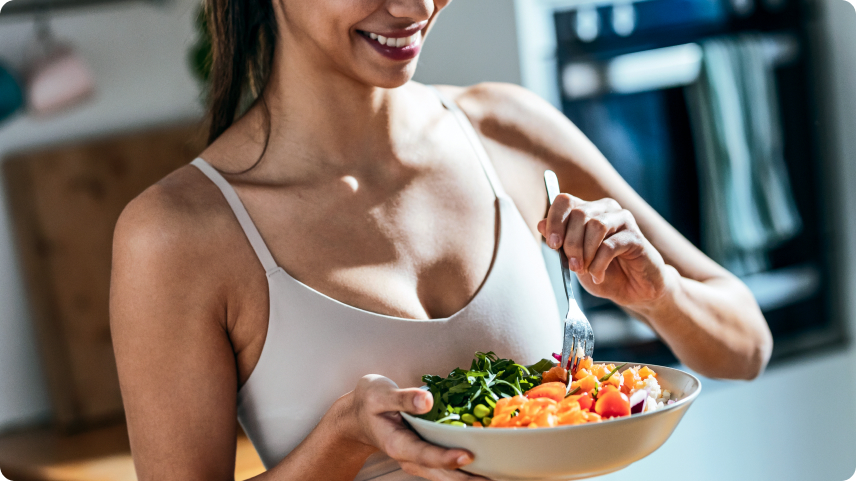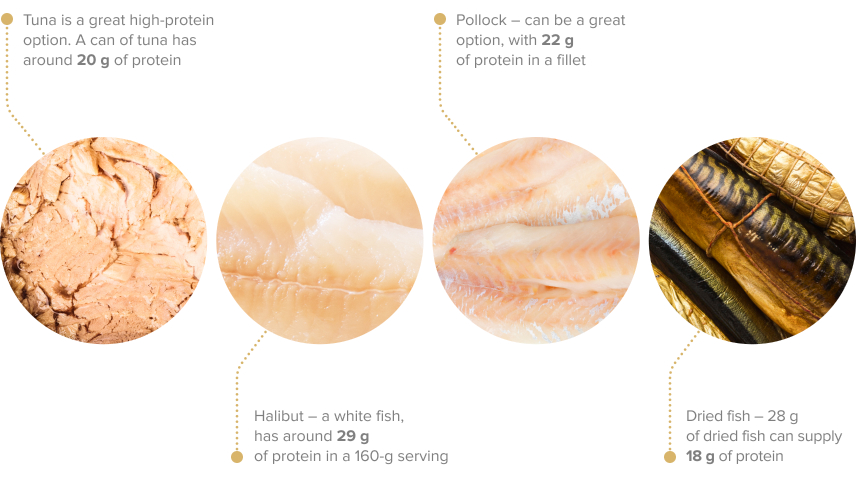Protein-containing foods: what to add to your diet

How Much Protein Do You Need?
The general guidance for people who don't lead an active lifestyle is to consume around 0.8 g of protein per kilo of weight. However, your requirements will vary if you're highly active, are an athlete, or are trying to change your body composition.
Those who are active and exercise regularly need to maintain their muscle mass. Therefore, they should consume around 1.4-2.0 grams of protein per kilo of body weight daily. For someone who weighs about 70 kg and wants to get 1.5 grams of protein per kilo, that amounts to about 105 grams of protein daily.
You'll need more protein if you're a well-trained individual who is preparing for competition and requires losing weight. You need to prioritize this nutrient to help preserve your muscle mass. In addition, the protein can keep you full, making the calorie deficit easier to tolerate. In this case, you'll need to adjust your intake to about 2.3-3.1 grams of protein per kilo daily. For those who are resistance-trained, going higher than 3 grams per kilo might be beneficial.

In addition, if you're over 65, increasing your protein intake's a good idea. The increase is modest, with the recommendation being to eat around 1.2-1.3 grams of protein per kilo per day. This is due to its ability to support a healthy musculoskeletal system in older people.
So you're ready to start a high-protein diet plan, but what foods can help you meet your goals? In this post, we'll help you learn more about the best high-protein foods to include in your diet.
Best High-Protein Foods
There is a range of whole foods that you can use to increase your protein intake. They include animal products and plant-based options. You can explore how these might fit your diet and preferences. Remember that to stick with a meal plan, you need to be eating foods you enjoy.
Salmon
Salmon is a popular fish, and for good reason. It’s versatile, easy to cook, and has plenty of good fatty acids. Alongside that, it is rich in protein.
About 100 grams of salmon can contain around 22-25 grams of protein. In addition, salmon provides beneficial nutrients, such as:
- Vitamins – salmon is rich in group B vitamins, which can support energy release from food. It’s also rich in vitamin D.
- Minerals – salmon is rich in potassium and selenium.
- Omega-3 fatty acids – these fats are good for you, as they help support cardiovascular health.
- Astaxanthin – this beneficial antioxidant can support healthy cholesterol levels.

However, always check the food labels to find out exactly how much protein and omega-3s you're getting from salmon. Wild-caught and farmed salmon may differ in their protein intake, with wild salmon having slightly more protein.
Eggs
Ovo-vegetarians and omnivores alike might wonder – are eggs high in protein? Indeed, they are.
We can consider eggs to be quite a superfood. Eggs are one of the best sources of high-quality protein our body can easily absorb, with a large egg providing just over 6 grams of protein. In addition, many of the proteins found in eggs have beneficial properties – some have antiviral and antibacterial properties. Egg protein can support muscle growth and fat loss and even help with proper cholesterol levels.
In addition, eggs supply a whole range of nutrients. Eggs are one of the few foods that naturally contain vitamin D. They provide vitamins like the B-group vitamins and vitamin A and minerals like selenium and iodine. Eggs also have beneficial antioxidants like lutein and zeaxanthin. They are also rich in choline, which is a nutrient required for proper brain function.
Therefore, eggs make a fantastic base for a high-protein meal.
Chicken
Chicken is an animal protein that often serves as a base for meals with high protein content. You may associate this type of protein with gym bros – their classic of chicken, broccoli, and rice is a staple for many who want to increase their protein intake. So, what's so great about chicken?
Chicken meat is a high-quality source of protein, with a high protein digestibility. It can have a range of fat content depending on the cut – cuts with skin tend to have more fat, while leaner cuts like breast can be as low as 1% fat. Therefore, depending on your overall body composition goals, you may need to choose the right part of the chicken to eat.
In addition, chicken, like many other animal meats, is high in vitamins and minerals. It provides B-group vitamins, like vitamin B12 and B6 and niacin. Chicken is rich in selenium. In addition, specific cuts of chicken can provide plenty of iron.
Beef
Beef is likely a protein source that many think of when they hear protein. 100 hundred grams of lean ground beef with 7% fat contains 21 grams of protein. In addition, beef is rich in vitamins like B12, B3 and B6. It also has plenty of selenium, iron, and zinc, making it a nutritious option.
Beef is a great high-protein option, but it should be consumed in moderation, as certain cuts can be high in saturated fats.

Turkey
Turkey is a type of poultry that many people enjoy for Thanksgiving or Christmas dinners. It’s very similar to chicken in its nutritional profile. A 100 grams of raw turkey meat can provide around 23 grams of protein.
Similar to other animal foods, it’s high in B-group vitamins, zinc, selenium, and choline.
However, it's best to check the food labels if you're a fan of processed turkey meat, such as turkey sausage or ham. Some of these foods can be high in salt and fats.
Fish
There are plenty of fish types that are high in protein, including:
- Tuna – whether you eat it canned or cook a tuna steak, it’s a great high-protein option. A can of tuna has around 20 grams of protein.
- Halibut – a white fish, has around 29 grams of protein in a 160-gram serving.
- Dried fish – 28 grams of dried fish can supply 18 grams of protein!
- Pollock – can be a great option, with 22 grams of protein in a fillet.

Cottage cheese
Many people like cheese, but how many regularly eat cottage cheese?
Cottage cheese is an often-overlooked source of protein, which is low in fat and has plenty of nutrients.
Half a cup of this food, or around 113 grams, provides approximately 14 grams of protein. In addition, there’s plenty of vitamin B6, choline, zinc, and copper in it. It’s a nutritious choice for those who consume milk products.
It's quite a versatile protein source, and it's an excellent base for snacks that are high in protein. For example, you can try making whipped cottage cheese with fruit or crackers as a balanced snack.
Milk
Milk is a food that is high in protein. One cup of milk can provide around 8 grams of protein and a varying amount of fat, depending on fat content.
There are two types of proteins in milk: soluble whey protein and casein, which is insoluble. Casein’s benefits include its ability to help us absorb minerals like calcium and phosphorus. On the other hand, whey is rich in BCAAs, which is great for muscle growth. Milk proteins are getting more attention due to their beneficial effects on health, as they can support immune function and may have antimicrobial properties.
Non-dairy milk can also provide some protein. However, the content will depend on what it is made from, so it's best to check the nutritional labels.
Lentils
Lentils are a type of legume, which are outstanding sources of proteins for vegetarians and vegans. There are many types of lentils, and their protein content may vary accordingly. In general, a cup of cooked lentils will provide around 18 grams of protein. In addition to the macronutrient, lentils are rich in fibre, B-group vitamins, iron, magnesium, zinc and copper. They are indeed a plant nutritional powerhouse.
Lentils are really easy to incorporate into any diet, and since they're affordable, they can be a great way to bulk out your meals. Not sure where to start? Try our lentil taco recipe!
Peanuts
Peanuts are nuts high in protein. 100 grams of peanuts have 24 grams of protein. However, they also have plenty of fats and calories. They contain minerals like calcium, magnesium, potassium, zinc and selenium. Therefore, make sure you’re paying attention to serving sizes when eating nuts as a protein source.
Protein powders
Are you aiming to get some more protein in you, but you’re not prepared to eat a piece of meat or a portion of bean stew? No worries there – protein powders can be a handy tool to have.
Protein powders tend to be made from milk and are called whey or casein protein powders. Most of these protein powders will have anywhere from 18 to 27 grams of protein per serving.

Vegan protein powders are made from soy, pea or rice protein. These tend to have less protein per serving but are still a convenient way to supplement your intake.
When you mix a protein powder with water or milk, you get a shake, usually with a sweet flavor. It makes a great snack when you need extra protein but don't feel like eating a meal.
In addition, protein powders can be helpful for making breakfasts high in protein. You can add them to oats, smoothies, yoghurts, or even pancakes to increase the protein content of your favorite breakfast foods. If you’re looking for inspiration, try making our breakfast pots or high-protein yoghurt with granola!
If you're curious about how to incorporate protein shakes into your routine, check out our posts on:
- Best proteins for weight-loss
- How to take casein
- How to take protein hydrolysates
- How to take whey protein
- How to take protein for muscle gain
How much protein is too much?
Is there such a thing as too much protein? It’s good to consume protein in moderation.
New evidence shows that in some cases, a long-term increase in protein is well-tolerated, especially in certain groups. High protein diets can help lose weight and may not have detrimental effects on cardiovascular health. Typically, those with healthy kidneys don't have to worry about any impact of a high-protein diet on kidney function. Those who may have issues with kidney function should consult a specialist before making changes to their diet.
As a rule of thumb, consult with a specialist before increasing your protein intake.
Increasing your protein intake can be beneficial if you're trying to put on muscle or if you're trying to lose weight. In this post, we've covered some great high-protein foods that you can incorporate into your meals. Remember that for best results, you'll need to pair them with nutritious whole grains, fruits and vegetables. Don’t forget to keep active and take care of your mental health as well.



